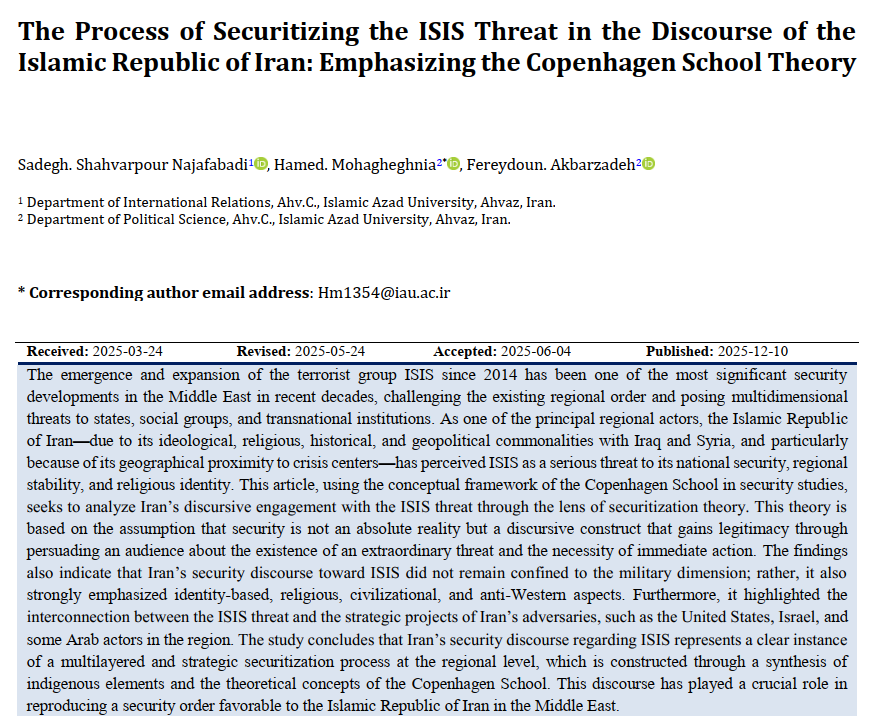The Process of Securitizing the ISIS Threat in the Discourse of the Islamic Republic of Iran: Emphasizing the Copenhagen School Theory
Keywords:
Securitization, ISIS, Iran, Copenhagen School, Middle EastAbstract
The emergence and expansion of the terrorist group ISIS since 2014 has been one of the most significant security developments in the Middle East in recent decades, challenging the existing regional order and posing multidimensional threats to states, social groups, and transnational institutions. As one of the principal regional actors, the Islamic Republic of Iran—due to its ideological, religious, historical, and geopolitical commonalities with Iraq and Syria, and particularly because of its geographical proximity to crisis centers—has perceived ISIS as a serious threat to its national security, regional stability, and religious identity. This article, using the conceptual framework of the Copenhagen School in security studies, seeks to analyze Iran’s discursive engagement with the ISIS threat through the lens of securitization theory. This theory is based on the assumption that security is not an absolute reality but a discursive construct that gains legitimacy through persuading an audience about the existence of an extraordinary threat and the necessity of immediate action. The findings also indicate that Iran’s security discourse toward ISIS did not remain confined to the military dimension; rather, it also strongly emphasized identity-based, religious, civilizational, and anti-Western aspects. Furthermore, it highlighted the interconnection between the ISIS threat and the strategic projects of Iran’s adversaries, such as the United States, Israel, and some Arab actors in the region. The study concludes that Iran’s security discourse regarding ISIS represents a clear instance of a multilayered and strategic securitization process at the regional level, which is constructed through a synthesis of indigenous elements and the theoretical concepts of the Copenhagen School. This discourse has played a crucial role in reproducing a security order favorable to the Islamic Republic of Iran in the Middle East.
Downloads
References
Afghahi, H., & Rasouli, F. (2018). Iran's Strategies in Confronting the ISIS Threat. International Politics Research Quarterly, 13(4), 89-110.
Aghajari, M., & Fattahi, M. (2020). Discourse Analysis of the Islamic Republic of Iran's Security Policy in the Post-JCPOA Era. Foreign Policy Quarterly, 34(2), 145-172.
Balzacq, T. (2005). The Three Faces of Securitization: Political Agency, Audience and Context. European Journal of International Relations, 11(2), 171-201. https://doi.org/10.1177/1354066105052960
Buzan, B., & Wæver, O. (2003). Regions and Powers: The Structure of International Security. Cambridge University Press. https://doi.org/10.1017/CBO9780511491252
Buzan, B., Wæver, O., & de Wilde, J. (1998). Security: A New Framework for Analysis. Lynne Rienner Publishers. https://doi.org/10.1515/9781685853808
Ehteshami, A., & Zweiri, M. (2017). Iran and the Rise of its Neoconservatives: The Politics of Tehran's Silent Revolution. I.B. Tauris.
Esfandiary, D., & Tabatabai, A. (2015). Iran's ISIS policy. International Affairs, 91(1), 1-15. https://doi.org/10.1111/1468-2346.12183
Hunter, S. T. (2010). Iran's Foreign Policy in the Post-Soviet Era: Resisting the New International Order. Praeger. https://doi.org/10.5040/9798400672514
Karami, S. (2019). The Representation of the ISIS Threat in Iranian Media. Media and Culture Quarterly, 12(1), 91-108.
Khezri, N., & Talebi, S. (2016). Discourse Analysis of Iran's Security Policy Using Laclau and Mouffe's Approach. Political Science Research Journal, 10(1), 21-45.
Mabon, S. (2018). Saudi Arabia and Iran: Power and Rivalry in the Middle East. I.B. Tauris. https://doi.org/10.4324/9781315229591-11
Roe, P. (2008). Actor, Audience(s) and Emergency Measures: Securitization and the UK's Decision to Invade Iraq. Security Dialogue, 39(6), 615-635. https://doi.org/10.1177/0967010608098212
Wæver, O. (1995). Securitization and Desecuritization. In In R. D. Lipschutz (Ed.), On Security (pp. 46-86). Columbia University Press.
Zohraei, S., & Sharifi, M. (2017). Iran's Foreign Policy Toward the Syrian Crisis: A Discourse Analysis. Regional Politics Research Journal, 5(3), 55-77.

Downloads
Additional Files
Published
Submitted
Revised
Accepted
Issue
Section
License
Copyright (c) 2025 Sadegh Shahvarpour Najafabadi, Hamed Mohagheghnia, Fereydoun Akbarzadeh (Author)

This work is licensed under a Creative Commons Attribution-NonCommercial 4.0 International License.





